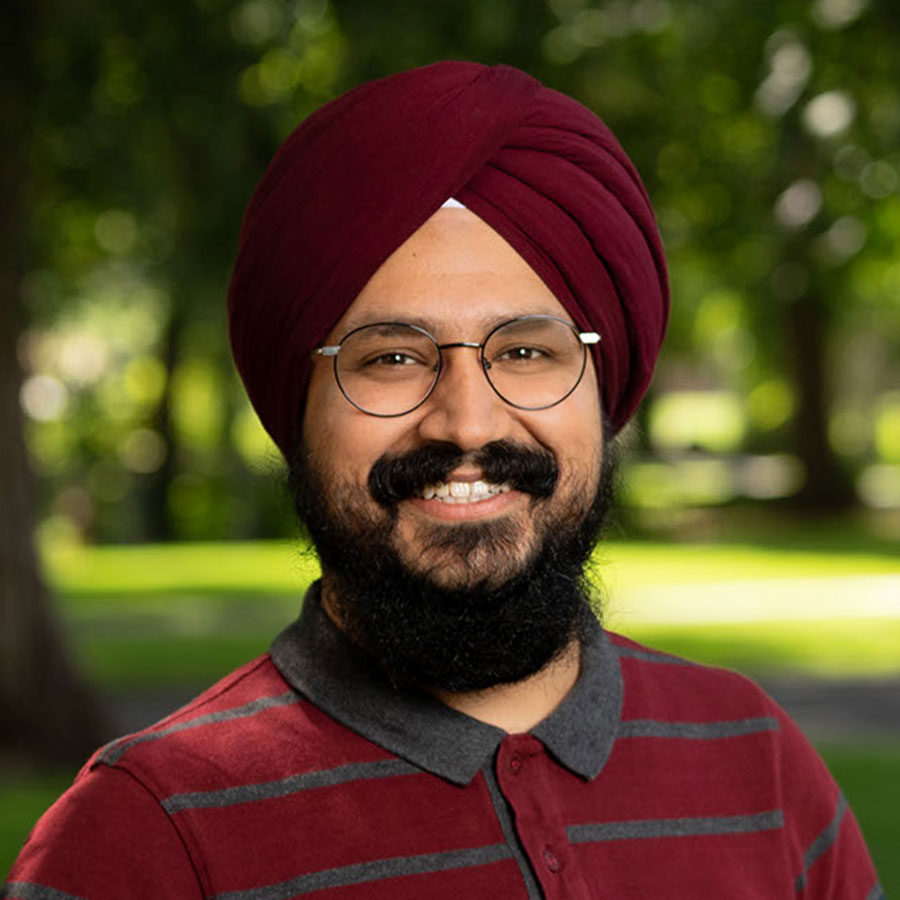

Ashmeet Singh
-
Hall of Science 250
-
509-527-5016
Professor Ashmeet Singh is a theoretical physicist, specializing in quantum mechanics and cosmology. A lot of his work involves thinking about fundamental problems in quantum physics, and its broader impact in cosmology, gravity, and possible signatures in experiment. Before starting at Whitman, he was a postdoctoral Research Scholar in physics at Caltech and a Visiting Affiliate at the NASA Jet Propulsion Laboratory. In addition to thinking about some of the most intriguing mysteries of the universe, Professor Singh has a passion for teaching physics in the classroom.
Professor Singh holds a Ph.D. in Physics (2020) from Caltech, a Masters in Physics (2018) also from Caltech, and an Integrated Masters of Science in Physics (2015) from the Indian Institute of Technology Roorkee.
He is also an amateur astronomer and astrophotographer who still hasn't gotten over the shimmering Milky Way. Outside of physics, he greatly enjoy traveling/roadtripping, particularly to National Parks and Forests, and indulging in Indian Classical Music.
The common thread in Prof. Singh's research is the interconnectivity of seemingly unrelated aspects of Nature's working, and how simple, yet powerful ideas thread it together. He is interested in studying foundational questions in quantum mechanics and its broader impact in cosmology, gravity, and their signatures in experiment.
Quantum mechanics, gravity, and cosmology have emerged as three key pillars of our fundamental understanding of the universe, and have been tremendously successful in making quantitative predictions for experiments in their respective domains. We anticipate an elegant unification of the microscopic quantum laws with those of gravity and cosmology that govern physics at the largest scales in our universe. However, quantum mechanics and gravity find themselves at strong odds in their current formulation, both conceptually and mathematically, and how they connect with underlying reality.
Prof. Singh's work falls into three broad categories, all hinged on quantum mechanics and quantum information, with an eye towards understanding their role in fundamental questions in gravity and cosmology: (i.) the role of quantum mechanics in the cosmological evolution of the universe, particularly early universe physics, (ii.) emergence of structure in quantum theory with an eye towards quantum gravity, and (iii.) tests of fundamental physics based on ideas at the intersection of quantum information and gravity.
He is also very interested in looking at connections between physics, statistics, and engineering. One such direction he has worked on is the application of Information Field Theory, in particular perturbative field theory techniques (basically Feynman diagrams) to Civil Engineering.
Friedrich, O., Singh, A. & Doré, O. Toolkit for Scalar Fields in Universes with Finite-Dimensional Hilbert Space, accepted for publication in Class. Quant. Gravity, arXiv:2201.08405 [gr-qc]
Singh, A., Probing the Quantum Nature of Gravity in the Microgravity of Space, White Paper written for the National Academies’ Decadal Survey on Biological and Physics Sciences (BPS) Research in Space 2023-2032, arXiv:2111.01711 [quant-ph]
Singh, A. & Doré, O. Does Quantum Physics Lead to Cosmological Inflation?, arXiv:2109.03049 [gen- ph]
Pandey, A., Singh, A. & Gardoni, P., A Review of Information Field Theory for Bayseian Inference of Random Fields, Structural Safety 99 (2022) 102225, https://doi.org/10.1016/j.strusafe.2022.102225
Carroll, S. M., & Singh, A., Quantum Mereology: Factorizing Hilbert Space into Subsystems with Quasi-classical Dynamics, Phys. Rev. A 103, 022213 (2021), arXiv:2005.12938 [quant-ph]
Singh, A., Quantum Space, Quantum Time, and Relativistic Quantum Mechanics, Quantum Stud.: Math. Found. 9, 3553 (2022), arXiv:2004.09139 [quant-ph]
Kabernik, O., Pollack, J., & Singh, A., Quantum State Reduction: Generalized Bipartitions from Algebras of Observables, Phys. Rev. A 101, 032303 (2020), arXiv:1909.12851 [quant-ph]
Cao, C., Chatwin-Davies, A., & Singh, A., How Low can Vacuum Energy go when your Fields are Finite-Dimensional, Int. J. Mod. Phys. D Vol. 28, No. 14, 1944006 (2019), arXiv:1905.11199 [hep-th]
Pollack, J., & Singh, A., Towards Space from Hilbert Space: Finding Lattice Structure in Finite- Dimensional Quantum Systems, Quantum Stud.: Math. Found. 6, 181 (2019), arXiv:1801.10168 [quant- ph]
Singh, A., & Carroll, S. M., Modeling Position and Momentum in Finite Dimensional Hilbert Spaces via Generalized Pauli Operators, arXiv:1806.10134 [quant-ph]
Carroll, S. M., & Singh, A., Mad-Dog Everettianism: Quantum Mechanics at Its Most Minimal, What is Fundamental?, Springer International Publishing, 95 (2019) arXiv:1801.08132 [quant-ph]
Singh, A., & Carroll, S. M., Quantum Decimation in Hilbert Space: Coarse Graining without Structure, Phys. Rev. A 97, 032111 (2018), arXiv:1709.01066 [quant-ph]
Bao, N., Carroll, S. M., & Singh, A., The Hilbert Space of Quantum Gravity is Locally Finite Dimensional, Int. J. Mod. Phys. D 26, 1743013 (2017), arXiv:1704.00066 [hep-th] .
Innovation in Education Grant, Center for Teaching, Learning & Outreach, California Institute of Technology, 2020
R Bruce Stewart Prize for Excellence in Physics Teaching, California Institute of Technology, 2019
ASCIT Excellence in Teaching Award, Associated Students of the California Institute of Technology, 2018
FQXi’s Physics Essay Contest on “What is Fundamental” 2018 Third Prize for the paper, Mad-Dog Everettianism: Quantum Mechanics at its Most Minimal
Institute Silver Medal for Academics, Indian Institute of Technology Roorkee, 2015
National Bal Shree Honor, Government of India, 2008